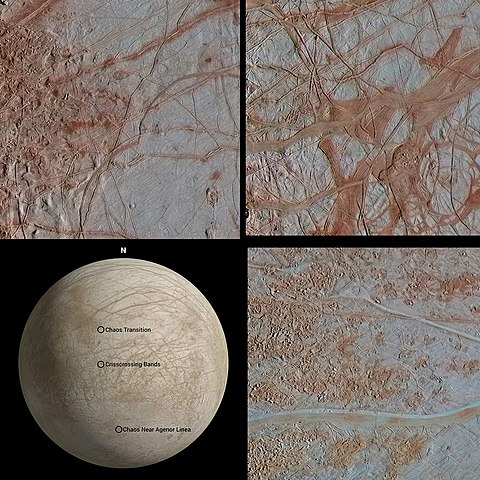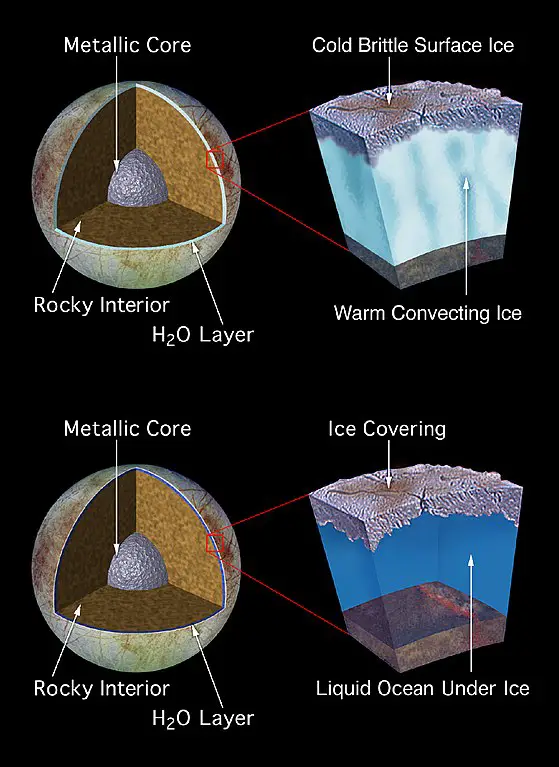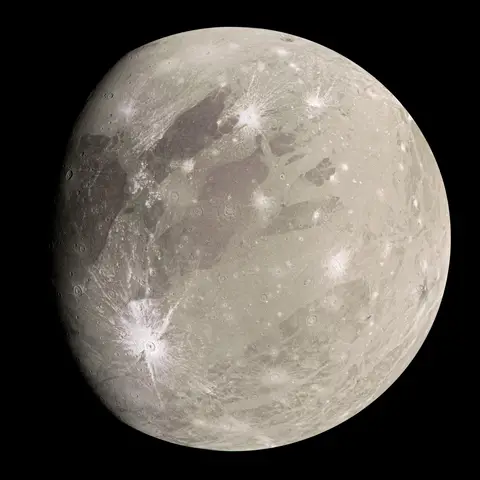Europa (Jupiter II) is the smallest of the four Galilean moons orbiting Jupiter, and the sixth-closest to the planet of all the 79 known moons of Jupiter. It is the sixth-largest moon in the Solar System.
Europa was discovered in 1610 by Galileo Galilei and was named after Europa, the Phoenician mother of King Minos of Crete.
Slightly smaller than Earth’s Moon, Europa is primarily made of silicate rock and has a water-ice crust and probably an iron–nickel core. It has a very thin atmosphere composed primarily of oxygen. Its surface is streaked by cracks and streaks, but craters are few.
Europa has the smoothest surface of any known solid object in the Solar System. The apparent youth and smoothness of the surface have led to the idea that a water ocean exists beneath it, which could maybe have extraterrestrial life. Sea salt from a subsurface ocean may be coating some geological features on Europa, suggesting that the ocean is interacting with the sea floor.
In addition, the Hubble Space Telescope detected water vapor plumes, which are thought to be caused by cryo-geysers.

linae on Europa
In 2018, astronomers provided evidence of water plume activity on Europa, based on data from the Galileo space probe. Such plume activity could help researchers in a search for life from the subsurface Europan ocean without having to land on the moon.
The Galileo mission, launched in 1989, provides the bulk of current data on Europa. No spacecraft has yet landed on Europa, although there have been several proposed exploration missions.
Facts
Europa was officially discovered by Galileo Galilei on the 8th of January 1610, along with the other Galilean moons of Jupiter.
Europa was named Jupiter II
Europa is still the sixth largest of the 181 moons in the solar system.
Europa is the smallest of the Galilean moons of Jupiter
The moon was named after Europa, daughter of the king of Tyre, a noblewoman in Greek mythology.
It is the sixth closest natural satellite to the planet.
Europa is just over 3,100 kilometers (1,900 mi) in diameter
Europa formed around 4.5 billion years ago.
Europa’s surface is only between 40 and 90 million years old, due to tidal flexing of the crust that maintains tectonic activity
The magnetic field of Europa is caused by the interaction with Jupiter’s magnetic field and may mean that there is something conductive beneath the ice.
It takes Europa 3.5 Earth days to orbit Jupiter
It takes 3.5 Earth days for Europa to rotate on its axis.
Europa is tidally locked to Jupiter meaning the same side of the moon always faces the planet.
Europa probably contains a metallic iron core.
The lines on Europa’s surface are called lineae
The closest Europa gets to Jupiter is about 413,126 miles.
The farthest Europa gets from Jupiter is about 420,629 miles.
Europa has the smoothest surface of any known solid object in the Solar System.
The largest crater on Europa is named Pwyll.
The Hubble Space Telescope detected water vapor plumes, which are thought to be caused by erupting cryo-geysers.
Europa has a very thin atmosphere that is mainly made up of oxygen.

Scientists believe that there is a liquid ocean somewhere around 100 km beneath the icy crust of Europa
Europa may be one of the most promising places in our solar system, to search for life
The moon’s icy surface gives it an albedo of 0.64, which places it among the brightest of all the known moons in the solar system.
It is theorized that the estimated volume of water on Europa is slightly more than double the volume of water in the oceans on Earth.
The radiation level at the surface of Europa is equivalent to a dose of about 540 rem per day which would kill a human being in only 1 day.
Europa has been visited by five spacecraft. The spacecraft were Pioneer 1 (1973), Pioneer 11 (1974), Voyager 1 (1979), Voyager 2 (1979), and Galileo (1995 to 2003).
Future missions to Europa include a NASA mission called Europa Clipper, and an ESA mission called Jupiter Icy Moon Explorer.
Information
| Discovery | |||||||||
|---|---|---|---|---|---|---|---|---|---|
| Discovered by | G. Galilei Marius, Simon |
||||||||
| Discovery date | January 7, 1610 | ||||||||
| Designations | |||||||||
|
Alternative names
|
Jupiter II | ||||||||
| Adjectives | Europan | ||||||||
| Orbital characteristics | |||||||||
| Epoch January 8, 2004 | |||||||||
| Periapsis | 664 862 km | ||||||||
| Apoapsis | 676 938 km | ||||||||
|
Mean orbit radius
|
670 900 km | ||||||||
| Eccentricity | 0.009 | ||||||||
|
Orbital period
|
3.551 181 d | ||||||||
|
Average orbital speed
|
13.740 km/s | ||||||||
| Inclination | 0.470° (to Jupiter’s equator) | ||||||||
| Satellite of | Jupiter | ||||||||
| Physical characteristics | |||||||||
|
Mean radius
|
1569 km (0.245 Earths) | ||||||||
|
Surface area
|
3.09×107 km2 (0.061 Earths) | ||||||||
| Volume | 1.593×1010 km3 (0.015 Earths) | ||||||||
| Mass | 4.80×1022 kg (0.008 Earths) | ||||||||
|
Mean density
|
3.01 g/cm3 | ||||||||
|
Surface gravity
|
1.314 m/s2 (0.134 g) | ||||||||
|
Escape velocity
|
2.025 km/s | ||||||||
|
Rotation period
|
Synchronous | ||||||||
|
Axial tilt
|
0.1° | ||||||||
| Albedo | 0.67 ± 0.03 | ||||||||
|
|||||||||
|
Apparent magnitude
|
5.29 (opposition) | ||||||||
| Atmosphere | |||||||||
|
Surface pressure
|
0.1 µPa (10-12 bar) | ||||||||
Links
We also have facts about some other moons of Jupiters like IO and Ganymede
Various facts about Jupiters moon Ganymede
Various facts about Jupiters moon Io

